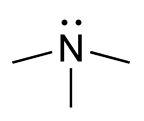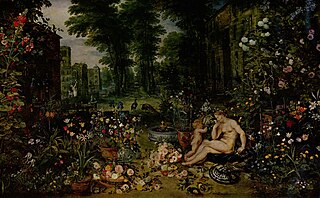Related Research Articles
A pheromone is a secreted or excreted chemical factor that triggers a social response in members of the same species. Pheromones are chemicals capable of acting like hormones outside the body of the secreting individual, to affect the behavior of the receiving individuals. There are alarm pheromones, food trail pheromones, sex pheromones, and many others that affect behavior or physiology. Pheromones are used by many organisms, from basic unicellular prokaryotes to complex multicellular eukaryotes. Their use among insects has been particularly well documented. In addition, some vertebrates, plants and ciliates communicate by using pheromones. The ecological functions and evolution of pheromones are a major topic of research in the field of chemical ecology.

Sexual attraction is attraction on the basis of sexual desire or the quality of arousing such interest. Sexual attractiveness or sex appeal is an individual's ability to attract other people sexually, and is a factor in sexual selection or mate choice. The attraction can be to the physical or other qualities or traits of a person, or to such qualities in the context where they appear. The attraction may be to a person's aesthetics, movements, voice, or smell, among other things. The attraction may be enhanced by a person's adornments, clothing, perfume or style. It can be influenced by individual genetic, psychological, or cultural factors, or to other, more amorphous qualities. Sexual attraction is also a response to another person that depends on a combination of the person possessing the traits and on the criteria of the person who is attracted.

The major histocompatibility complex (MHC) is a large locus on vertebrate DNA containing a set of closely linked polymorphic genes that code for cell surface proteins essential for the adaptive immune system. These cell surface proteins are called MHC molecules.

The human leukocyte antigen (HLA) system or complex is a complex of genes on chromosome 6 in humans which encode cell-surface proteins responsible for regulation of the immune system. The HLA system is also known as the human version of the major histocompatibility complex (MHC) found in many animals.
Disassortative mating is a mating pattern in which individuals with dissimilar phenotypes mate with one another more frequently than would be expected under random mating. Disassortative mating reduces the mean genetic similarities within the population and produces a greater number of heterozygotes. The pattern is character specific, but does not affect allele frequencies. This nonrandom mating pattern will result in deviation from the Hardy-Weinberg principle.
Body odor or body odour (BO) is present in all animals and its intensity can be influenced by many factors. Body odor has a strong genetic basis, but can also be strongly influenced by various diseases and physiological conditions. Though body odor has played an important role in early humankind, it is generally considered to be an unpleasant odor amongst many human cultures.

The axilla is the area on the human body directly under the shoulder joint. It includes the axillary space, an anatomical space within the shoulder girdle between the arm and the thoracic cage, bounded superiorly by the imaginary plane between the superior borders of the first rib, clavicle and scapula, medially by the serratus anterior muscle and thoracolumbar fascia, anteriorly by the pectoral muscles and posteriorly by the subscapularis, teres major and latissimus dorsi muscle.

Physical attractiveness is the degree to which a person's physical features are considered aesthetically pleasing or beautiful. The term often implies sexual attractiveness or desirability, but can also be distinct from either. There are many factors which influence one person's attraction to another, with physical aspects being one of them. Physical attraction itself includes universal perceptions common to all human cultures such as facial symmetry, sociocultural dependent attributes and personal preferences unique to a particular individual.

Androstenone (5α-androst-16-en-3-one) is a 16-androstene class steroidal pheromone. It is found in boar's saliva, celery cytoplasm, and truffle fungus. Androstenone was the first mammalian pheromone to be identified. It is found in high concentrations in the saliva of male pigs, and, when inhaled by a female pig that is in heat, results in the female assuming the mating stance. Androstenone is the active ingredient in 'Boarmate', a commercial product made by DuPont sold to pig farmers to test sows for timing of artificial insemination.

Trimethylaminuria (TMAU), also known as fish odor syndrome or fish malodor syndrome, is a rare metabolic disorder that causes a defect in the normal production of an enzyme named flavin-containing monooxygenase 3 (FMO3). When FMO3 is not working correctly or if not enough enzyme is produced, the body loses the ability to properly convert trimethylamine (TMA) from precursor compounds in food digestion into trimethylamine oxide (TMAO), through a process called N-oxidation. Trimethylamine then builds up and is released in the person's sweat, urine, and breath, giving off a fishy odor. Primary trimethylaminuria is caused by genetic mutations that affect the FMO3 function of the liver. Symptoms matching TMAU can also occur when there is no genetic cause, yet excessive TMA excreted - this has been described as secondary trimethylaminuria (TMAU2). TMAU2 can be caused simply by a precursor overload, hormonal issues related to menstrual cycles, liver damage, or liver and kidney failure. As a symptom rather than a disease, TMAU2 is temporary and will resolve as the underlying cause is remedied.

Mate choice is one of the primary mechanisms under which evolution can occur. It is characterized by a "selective response by animals to particular stimuli" which can be observed as behavior. In other words, before an animal engages with a potential mate, they first evaluate various aspects of that mate which are indicative of quality—such as the resources or phenotypes they have—and evaluate whether or not those particular trait(s) are somehow beneficial to them. The evaluation will then incur a response of some sort.
Interpersonal compatibility or interpersonal matching is the long-term interaction between two or more individuals in terms of the ease and comfort of communication.

An odor or odour is caused by one or more volatilized chemical compounds that are generally found in low concentrations that humans and many animals can perceive via their sense of smell. An odor is also called a "smell" or a "scent", which can refer to either a pleasant or an unpleasant odor.

The sense of smell, or olfaction, is the special sense through which smells are perceived. The sense of smell has many functions, including detecting desirable foods, hazards, and pheromones, and plays a role in taste.
Genetic matchmaking is the idea of matching couples for romantic relationships based on their biological compatibility. The initial idea was conceptualized by Claus Wedekind through his "sweaty t-shirt" experiment. Males were asked to wear T-shirts for two consecutive nights, and then females were asked to smell the T-shirts and rate the body odors for attractiveness. Human body odor has been associated with the human leukocyte antigens (HLA) genomic region. They discovered that females were attracted to men who had dissimilar HLA alleles from them. Furthermore, these females reported that the body odors of HLA-dissimilar males reminded them of their current partners or ex-partners providing further evidence of biological compatibility.
Odour is sensory stimulation of the olfactory membrane of the nose by a group of molecules. Certain body odours are connected to human sexual attraction. Humans can make use of body odour subconsciously to identify whether a potential mate will pass on favourable traits to their offspring. Body odour may provide significant cues about the genetic quality, health and reproductive success of a potential mate.

The major histocompatibility complex in sexual selection concerns how major histocompatibility complex (MHC) molecules allow for immune system surveillance of the population of protein molecules in a host's cells. In 1976, Yamazaki et al. demonstrated a sexual selection mate choice by male mice for females of a different MHC.
The ovulatory shift hypothesis holds that women experience evolutionarily adaptive changes in subconscious thoughts and behaviors related to mating during different parts of the ovulatory cycle. It suggests that what women want, in terms of men, changes throughout the menstrual cycle. Two meta-analyses published in 2014 reached opposing conclusions on whether the existing evidence was robust enough to support the prediction that women's mate preferences change across the cycle. A newer 2018 review does not show women changing the type of men they desire at different times in their fertility cycle.
In humans, males and females differ in their strategies to acquire mates and focus on certain qualities. There are two main categories of strategies that both sexes utilize: short-term and long-term. Human mate choice, an aspect of sexual selection in humans, depends on a variety of factors, such as ecology, demography, access to resources, rank/social standing, genes, and parasite stress.

Olfactic communication is a channel of nonverbal communication referring to the various ways people and animals communicate and engage in social interaction through their sense of smell. Our human olfactory sense is one of the most phylogenetically primitive and emotionally intimate of the five senses; the sensation of smell is thought to be the most matured and developed human sense.
References
- ↑ Wedekind, C.; et al. (1995). "MHC-dependent preferences in humans". Proceedings of the Royal Society of London. 260 (1359): 245–49. doi:10.1098/rspb.1995.0087. PMID 7630893.
- ↑
- Furlow, Bryant., F. (1996). "The Smell of Love Archived 2013-02-01 at archive.today ." Psychology Today Mar/Apr.
- ↑ Scent of a Man Archived 2007-05-27 at the Wayback Machine - New Scientist Feb 10, 2001
- ↑ Elder, Rob. (2001). "The Science of Attraction Archived 2007-06-23 at the Wayback Machine ," Journal of Hybrid Vigor, Emory University, Issue 1.
- ↑ Boehm, T; Zufall, F. (Feb 2006). "MHC peptides and the sensory evaluation of genotype". Trends Neurosci. 29 (2): 100–7. doi:10.1016/j.tins.2005.11.006. PMID 16337283.
- ↑ Wedekind C, Füri S. Body odour preferences in men and women: do they aim for specific MHC combinations or simply heterozygosity? Proc R Soc Lond B1997; 264: 1471–1479
- ↑ Wedekind, C.; Seebeck, T.; Bettens, F.; Paepke, A. J. (1995). "MHC-dependent mate preferences in humans". Proc Biol Sci. 260 (1359): 245–249. doi:10.1098/rspb.1995.0087. PMID 7630893.
- ↑ Santos, PS; Schinemann, JA; Gabardo, J; Bicalho Mda, G. (Apr 2005). "New evidence that the MHC influences odor perception in humans: a study with 58 Southern Brazilian students". Horm Behav. 47 (4): 384–8. doi:10.1016/j.yhbeh.2004.11.005. PMID 15777804.